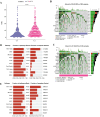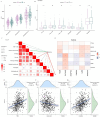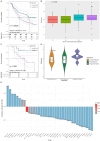Development of a reliable risk prognostic model for lung adenocarcinoma based on the genes related to endotheliocyte senescence
- PMID: 40221448
- PMCID: PMC11993614
- DOI: 10.1038/s41598-025-95551-4
Development of a reliable risk prognostic model for lung adenocarcinoma based on the genes related to endotheliocyte senescence
Abstract
Cellular senescence is a hallmark for cancers, particularly in lung adenocarcinoma (LUAD). This study developed a risk model using senescence signature genes for LUAD patients. Based on the RNA-seq, clinical information and mutation data of LUAD patients collected from the TCGA and GEO database, we obtained 102 endotheliocyte senescence-related genes. The "ConsensusClusterPlus" R package was employed for unsupervised cluster analysis, and the "limma" was used for the differentially expressed gene (DEG) analysis. A prognosis model was created by univariate and multivariate Cox regression analysis combined with Lasso regression utilizing the "survival" and "glmnet" packages. KM survival and receiver operator characteristic curve analyses were conducted applying the "survival" and "timeROC" packages. "MCPcounter" package was used for immune infiltration analysis. Immunotherapy response analysis was performed based on the IMvigor210 and GSE78220 cohort, and drug sensitivity was predicted by the "pRRophetic" package. Cell invasion and migration were tested by carrying out Transwell and wound healing assays. According to the results, a total of 32 genes related to endotheliocyte senescence were screened to assign patients into C1 and C2 subtypes. The C2 subtype showed a significantly worse prognosis and an overall higher somatic mutation frequency, which was associated with increased activation of cancer pathways, including Myc_targets2 and angiogenesis. Then, based on the DEGs between the two subtypes, we constructed a five-gene RiskScore model with a strong classification effectiveness for short- and long-term OS prediction. High- and low-risk groups of LUAD patients were classified by the RiskScore. High-risk patients, characterized by lower immune infiltration, had poorer outcomes in both training and validation datasets. The RiskScore was associated with the immunotherapy response in LUAD. Finally, we found that potential drugs such as Cisplatin can benefit high-risk LUAD patients. In-vitro experiments demonstrated that silencing of Angiopoietin-like 4 (ANGPTL4), Gap Junction Protein Beta 3 (GJB3), Family with sequence similarity 83-member A (FAM83A), and Anillin (ANLN) reduced the number of invasive cells and the wound healing rate, while silencing of solute carrier family 34 member 2 (SLC34A2) had the opposite effect. This study, collectively speaking, developed a prognosis model with senescence signature genes to facilitate the diagnosis and treatment of LUAD.
Keywords: ConsensusClusterPlus; Immune-infiltration; Lung adenocarcinoma (LUAD); RiskScore; Senescence signature.
© 2025. The Author(s).
Conflict of interest statement
Declarations. Ethics approval and consent to participate: Not applicable. Consent for publication: Not applicable. Competing interests: The authors declare no competing interests.
Figures










Similar articles
-
A nicotinamide metabolism-related gene signature for predicting immunotherapy response and prognosis in lung adenocarcinoma patients.PeerJ. 2025 Feb 27;13:e18991. doi: 10.7717/peerj.18991. eCollection 2025. PeerJ. 2025. PMID: 40034678 Free PMC article.
-
Integrative analysis of a novel signature incorporating metabolism and stemness-related genes for risk stratification and assessing clinical outcomes and therapeutic responses in lung adenocarcinoma.BMC Cancer. 2025 Apr 1;25(1):591. doi: 10.1186/s12885-025-13984-6. BMC Cancer. 2025. PMID: 40170009 Free PMC article.
-
Single-Cell Transcriptomic Profiling Reveals KRAS/TP53-Driven Neutrophil Reprogramming in Luad: A Multi-Gene Prognostic Model and Therapeutic Targeting of RHOV.Oncol Res. 2025 May 29;33(6):1383-1404. doi: 10.32604/or.2025.062584. eCollection 2025. Oncol Res. 2025. PMID: 40486872 Free PMC article.
-
C6 and KLRG2 are pyroptosis subtype-related prognostic biomarkers and correlated with tumor-infiltrating lymphocytes in lung adenocarcinoma.Sci Rep. 2024 Oct 22;14(1):24861. doi: 10.1038/s41598-024-75650-4. Sci Rep. 2024. PMID: 39438534 Free PMC article.
-
Exploring the molecular and immune landscape of cellular senescence in lung adenocarcinoma.Front Immunol. 2024 Aug 29;15:1347770. doi: 10.3389/fimmu.2024.1347770. eCollection 2024. Front Immunol. 2024. PMID: 39267750 Free PMC article.
Cited by
-
Development and validation of transient receptor potential channel-related signature for predicting prognosis in patients with lung adenocarcinoma.Oncol Lett. 2025 Jul 29;30(4):464. doi: 10.3892/ol.2025.15210. eCollection 2025 Oct. Oncol Lett. 2025. PMID: 40787424 Free PMC article.
References
-
- Tang, Z., Wang, L., Wu, G., Qin, L.& Tan, Y. FGD5 as a novel prognostic biomarker and its association with immune infiltrates in lung adenocarcinoma. Biocell47 (11), 2503–2516 (2023).
-
- Bray, F. et al. Global cancer statistics 2022: GLOBOCAN estimates of incidence and mortality worldwide for 36 cancers in 185 countries. CA-Cancer J. Clin.74 (3), 229–263 (2024). - PubMed
-
- Cao, H. et al. Identification of prognostic molecular subtypes and model based on CD8 + T cells for lung adenocarcinoma. Biocell48 (3), 473–490 (2024).
MeSH terms
Substances
Grants and funding
LinkOut - more resources
Full Text Sources
Medical
Miscellaneous

